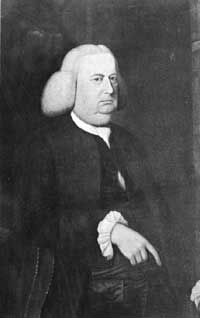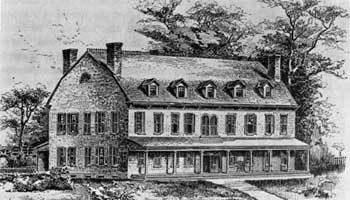







Biographical Sketches
|
PHILIP LIVINGSTON New York |
 Philip Livingston | |
| ||
Livingston was the fifth son of Philip Livingston, second lord of Livingston Manor, of Scotch descent, and Catherine Van Brugh, of Dutch lineage. Young Livingston was born in 1716 at his father's townhouse in Albany and spent most of his childhood there or at the family manor at Linlithgo, about 30 miles to the south.
Upon receiving a degree from Yale in 1737, Livingston entered the import business in New York City. Three years later, he married and moved into a townhouse on Duke Street in Manhattan; he was to sire five sons and four daughters. As time went on, he built up a fortune, particularly as a trader-privateer during the French and Indian War (1754-63). In 1764, though retaining his Duke Street home, he acquired a 40-acre estate on Brooklyn Heights overlooking the East River and New York Harbor.
 |
| The Brooklyn home of Philip Livingston from 1764 until his death in 1778. When the British occupied New York, they used it as a hospital. In 1811 fire destroyed it. (Pen and ink drawing by an unknown artist, from Magazine of American History, December 1885, Library of Congress.) |
While prospering as a merchant, Livingston devoted many of his energies to humanitarian and philanthropic endeavors. Among the organizations he fostered, financially aided, or helped administer were King's College (later Columbia University), the New York Society Library, St. Andrew's Society, the New York Chamber of Commerce, and New York Hospital.
Livingston was also a proponent of political and religious freedom. As a New York City alderman (1754-63), he identified with the popular party that opposed the aristocratic ruling class of the colony. In a decade of service (1759-69) in the colonial legislature, he stood behind the Whigs in their quarrel with the Royal Governor and attended the Stamp Act Congress in 1765. But, a believer in the sort of dignified protests mounted by lawyers and merchants, he resented the riotous behavior of such groups as the Sons of Liberty.
In the 1769 elections the Tories gained control of the legislature. In his bid for reelection, Livingston, fearful of the rise of extremism among the populace, attempted to unite the moderate factions. Defeated in New York City, which from then on was Tory-dominated, he managed to obtain reelection from the Livingston Manor district. The new assembly, claiming he could not represent an area in which he did not reside, unseated him.
In 1774 Livingston became a member of the committee of fifty-one, an extralegal group that selected New York City Delegates to the Continental Congress, one of whom was Livingston. He also served on the committee of sixty, formed to enforce congressional enactments. The next year, he won election to the committee of one hundred, which governed New York City temporarily until the first provincial congress of the colony met later that year.
Between 1774 and 1778 Livingston divided his time between the Continental Congress and the New York provincial assembly/legislature. In Congress he sat on committees dealing with marine, commerce, finance, military, and Indian matters. He was absent on July 1-2, 1776, perhaps on purpose even though the New York Delegates abstained from voting on the independence issue, but on August 2 he signed the Declaration.
After their defeat in the Battle of Long Island (August 27, 1776), Washington and his officers met at Livingston's residence in Brooklyn Heights and decided to evacuate the island. Subsequent to the ill-fated peace negotiations at Staten Island in September between Admiral Lord Richard Howe and three representatives of the Continental Congress, the British occupied New York City. They utilized Livingston's Duke Street home as a barracks and his Brooklyn Heights residence as a Royal Navy hospital, as well as confiscating his business interests. He later sold some of his remaining property to sustain public credit. With the advance of the British, Livingston and his family had fled to Esopus (later Kingston), N.Y., where the State capital was temporarily located before moving to nearby Poughkeepsie.
Livingston passed away at the age of 62 in 1778, the third earliest signer to die (after John Morton and Button Gwinnett). At the time, though in poor health, he was still in Congress, then meeting at York, Pa. He is buried in Prospect Hill Cemetery in that city.
Drawing: Oil, ca. 1770, probably by Abraham Delanoy, Jr. Frick Art Reference Library, New York City, and Taconic State Park Commission, Staatsburg, N.Y.
 |
 |
http://www.cr.nps.gov/history/online_books/declaration/bio28.htm
Last Updated: 04-Jul-2004